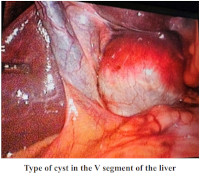Comparison of Traditional and New Methods of Obliterating Residual Space After Echinococcectomy
Main Article Content
Abstract
In the surgery of liver echinococcosis in the Republic of Uzbekistan, organpreserving minimally invasive and traditional interventions continue to dominate in clinics with various levels of healthcare. Against this background, one of the urgent issues remains the option of treating the residual cavity after echinococcectomy, implying both antiparasitic efficacy and the possibility of accelerating the process of obliteration of the fibrous capsule. This study highlights the results of echinococcectomy of the liver, considering the method of treatment of residual cavities with elastic and rigid fibrous capsules. It was determined that an improved method of treating the residual cavity in uncomplicated forms of liver echinococcosis in the presence of an elastic fibrous capsule that subsides after parasite extraction includes laser radiation. This provides the possibility of treating cavities of any configuration and inhibiting the growth of the pathogenic flora. When combined with the powdered composition "HEMOBEN" this method promotes local hemo and lymphostasis, sealing of microspheres bile ducts and increased obliteration of the walls of the fibrous capsule both during suturing and vacuum drainage. In another method, the use of high-energy laser exposure results in the destruction of a dense, rigid (nondisintegrating) fibrous capsule, ensuring not only the pliability of its walls by creating folds in the zones of induced destruction (by the type of pleating) but also the formation of zones of enhanced regeneration. Sanitisation of the residual cavity with FarGALS solution after preliminary laser destruction provides additional antiparasitic chemical effects owing to the penetration of the antiseptic
into the deep layers of the thickened capsule. Thus, this method can be used as an alternative to pericystectomy and liver resection.
Article Details

This work is licensed under a Creative Commons Attribution-NonCommercial-NoDerivatives 4.0 International License.
References
Schweiger, A., Ammann, R. W., Candinas, D., Clavien, P., Eckert, J., Gottstein, B., Halkic, N., Muellhaupt, B., Prinz, B. M., Reichen, J., Tarr, P. E., Torgerson, P. R., & Deplazes, P. (2007). Human Alveolar Echinococcosis after Fox Population Increase, Switzerland. Emerging Infectious Diseases, 13(6), 878 – 882. https://doi.org/10.3201/eid1306.061074
Wen, H., Vuitton, L., Tuxun, T., Li, J., Vuitton, D. A., Zhang, W., & McManus, D. P. (2019). Echinococcosis: Advances in the 21st century. Clinical Microbiology Reviews, 32(2). https://doi.org/10.1128/cmr.00075-18
Zhao, Z., Yin, Z., Meng, Y., Jiang, N., Ma, Z., Pan, L., Tan, X., Chen, X., & Liu, R.(2020). Successful robotic radical resection of hepatic echinococcosis located in posterosuperior liver segments. World Journal of Gastroenterology, 26(21), 2831–2838. https://doi.org/10.3748/wjg.v26.i21.2831
Shera, T. A., Choh, N. A., Gojwari, T. A., Shera, F. A., Shaheen, F. A., Wani, G. M., Robbani, I., Chowdri, N. A., & Shah, A. H. (2017). A comparison of imaging guided double percutaneous aspiration injection and surgery in the treatment of cystic echinococcosis of liver. British Journal of Radiology, 90(1072), 20160640. https://doi.org/10.1259/bjr.20160640
Robles R, Parilla P. Abscesos y quistes hepáticos. Guías Clínicas de la A.E.C. Cirugía Hepática. Madrid: Arán Ediciones; 2018. p. 106-23.
Ramia, J. M., Serrablo, A., Serradilla, M., Lopez-Marcano, A., De La Plaza, R., & Palomares, A. (2018). Major hepatectomies in liver cystic echinococcosis: Abi-centric experience. Retrospective cohort study. International Journal of Surgery, 54, 182–186. https://doi.org/10.1016/j.ijsu.2018.04.049
Keong, B., Wilkie, B., Sutherland, T., & Fox, A. (2017). Hepatic cystic echinococcosis in Australia: an update on diagnosis and management. ANZ Journal of Surgery, 88(1–2), 26–31. https://doi.org/10.1111/ans.14117
Brunetti, E., Kern, P., & Vuitton, D. A. (2009). Expert consensus for the diagnosis and treatment of cystic and alveolar echinococcosis in humans.Acta Tropica, 114(1), 1–16. https://doi.org/10.1016/j.actatropica.2009.11.001
Shera, T. A., Choh, N. A., Gojwari, T. A., Shera, F. A., Shaheen, F. A., Wani, G. M., Robbani, I., Chowdri, N. A., & Shah, A. H. (2017b). A comparison of imaging guided double percutaneous aspiration injection and surgery in the treatment of cystic echinococcosis of liver. British Journal of Radiology, 90(1072), 20160640. https://doi.org/10.1259/bjr.20160640
Bastid C, Terraz S, Toso C, Chappuis F, Spahr L, Bresson-Hadni S. Actualités sur l’échinococcose kystique hépatique [Update on cystic echinococcosis of the liver]. Rev Med Suisse. 2021 Sep 1;17(748):1466-1473. French. PMID: 34468098.
Jaén-Torrejimeno, I., López-Guerra, D., Rojas-Holguín, A., De-Armas-Conde, N., & Blanco-Fernández, G. (2022). Surgical treatment of liver hydatid cyst in elderly patients: A propensity score-matching retrospective cohort study. Acta Tropica, 232, 106466. https://doi.org/10.1016/j.actatropica.2022.106466
Bektasoglu, H. K., Hasbahceci, M., Tasci, Y., Aydogdu, I., Malya, F. U., Kunduz, E., & Dolay, K. (2019). Comparison of laparoscopic and Conventional Cystotomy/Partial cystectomy in treatment of liver hydatidosis. BioMed Research International, 2019, 1–5. https://doi.org/10.1155/2019/1212404
Baraket, O., Moussa, M., Ayed, K., Kort, B., & Bouchoucha, S. (2014). Predictive factors of morbidity after surgical treatment of hydatid cyst of the liver. Arab Journal of Gastroenterology, 15(3–4), 119–122. https://doi.org/10.1016/j.ajg.2014.05.004
Bockhorn, M., Sotiropoulos, G. C., Sgourakis, G., Neuhaus, J. P., Molmenti, E. P., Lang, H., Frilling, A., & Broelsch, C. E. (2008). Major liver resections in the elderly—is an aggressive approach justified? International Journal of Colorectal Disease, 24(1), 83–86. https://doi.org/10.1007/s00384-008-0571-4
Cho, S. W., Steel, J., Tsung, A., Marsh, J. W., Geller, D. A., & Gamblin, T. C. (2010). Safety of liver resection in the elderly: How important is age? Annals of Surgical Oncology, 18(4), 1088–1095. https://doi.org/10.1245/s10434-010- 1404-6
Kumari, S., Semira, C., Lee, M., Lee, B., Wong, R., Nott, L., Shapiro, J., & Gibbs, P. (2020). Resection of colorectal cancer liver metastases in older patients. ANZ Journal of Surgery, 90(5), 796–801. https://doi.org/10.1111/ans.15750
Babadjanov, A. K., Yakubov, F. R., Ruzmatov, P. Y., & Sapaev, D. S. (2021). Epidemiological aspects of echinococcosis of the liver and other organs in the Republic of Uzbekistan. Parasite Epidemiology and Control, 15, e00230. https://doi.org/10.1016/j.parepi.2021.e00230
Sapaev, D. S., Yakubov, F. R., & Yakhshiboev, S. S. (2023). Evaluation of the factors influencing the choice of laparoscopic echinococcectomy in liver echinococcosis (LE) and its impact on postoperative outcomes. Experimental Parasitology, 248, 108495. https://doi.org/10.1016/j.exppara.2023.108495


